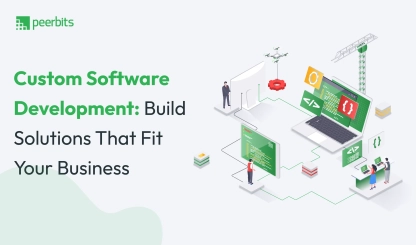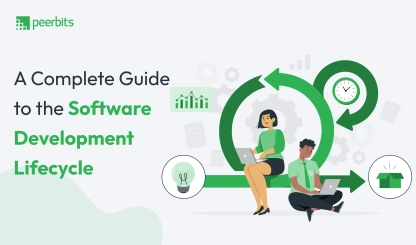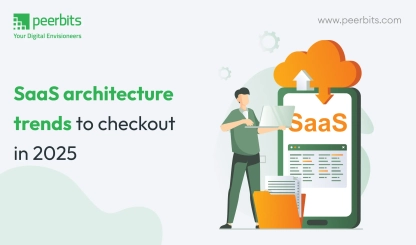Imagine launching a software product after months of development, only to see users struggling with confusing navigation, hidden features, and frustrating workflows. When software doesn’t align with user needs, adoption rates drop, complaints increase, and retention suffers.
According to Wikipedia, nearly 25% of users abandon a mobile application after using it just once. If an app fails to provide a smooth, intuitive experience from the start, users won’t give it a second chance.
Poor user experience not only damages reputation but also increases support costs and leads to expensive redesigns. A well-structured user-centered design process ensures software works for users, not against them.
This blog covers User-Centered Design in Software Development, its advantages, and how businesses can create products that users actually want to engage with. Whether improving an existing product or launching a new one, applying user-centered design principles can make all the difference.
What is user-centered design in software?
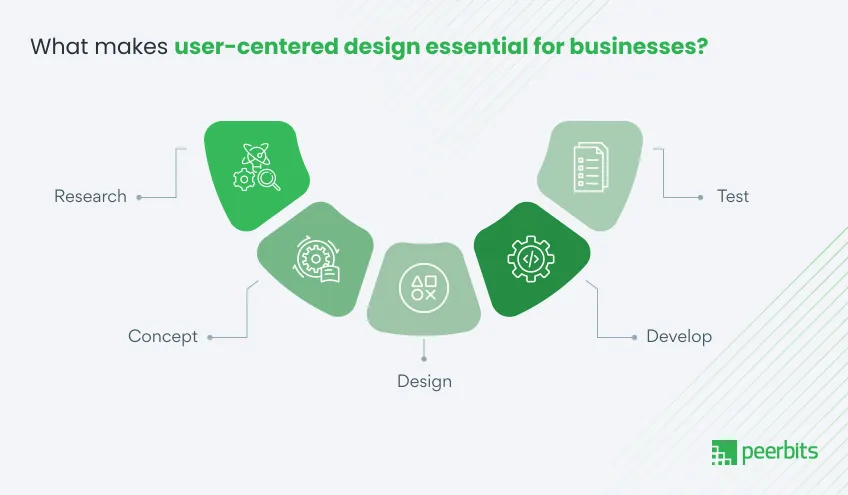
User-Centered Design (UCD) in software development focuses on creating products that prioritize user needs, behaviors, and expectations throughout the development cycle.
Unlike traditional methods where design decisions are based on assumptions, UCD relies on continuous user feedback, testing, and iterative improvements to build software that is intuitive and efficient.
Definition & core principles
User-centered design follows key principles that shape how software is built:
- User involvement at every stage: From initial research to final testing, users provide input to refine the design.
- Usability as the primary goal: The software must be easy to use, reducing frustration and improving efficiency.
- Iterative design and feedback loops: The process includes repeated testing and refinements based on real user feedback.
- Accessibility and inclusivity: Design considers different user abilities, ensuring the software is usable by a wider audience.
UCD vs. human-centered design
| Aspect | User-Centered Design (UCD) | Human-Centered Design (HCD) |
|---|---|---|
| Scope | Focuses specifically on software and digital interfaces. | Covers broader human experiences, including physical products and services. |
| Application | Used in software development to improve usability. | Applied in various industries, including healthcare, architecture, and service design. |
| User Involvement | Engages users through testing, feedback loops, and iterative design. | Involves users at a more strategic level to enhance overall human experiences. |
| Outcome | Results in intuitive, user-friendly software. | Improves experiences across multiple domains, not just digital solutions. |
UCD vs. design thinking
| Aspect | User-Centered Design (UCD) | Design Thinking |
|---|---|---|
| Focus | Enhancing usability and functionality in software. | Solving complex problems creatively. |
| When Used | Throughout the software development lifecycle. | Primarily in early-stage ideation and innovation. |
| Process | Iterative improvements based on user feedback | Brainstorming, prototyping, and testing to generate ideas. |
| Outcome | Practical, accessible, and user-friendly software. | Innovative solutions, which may or may not be software-related. |
This structured approach ensures that User-Centered Design in Software Development results in software that is practical, accessible, and user-friendly. The next section will explore the advantages of user-centered design and why businesses should adopt it.
Business impact of user-centered design
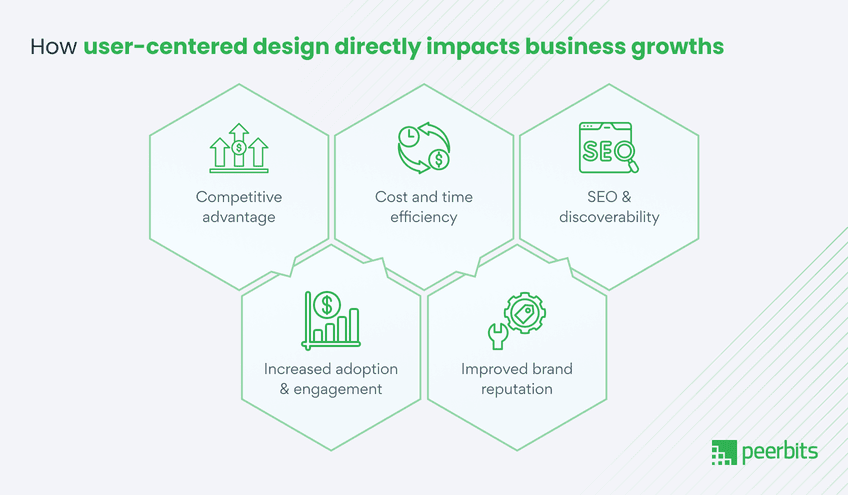
User-Centered Design in Software Development isn’t just about creating visually appealing interfaces. It directly impacts business success by improving usability, customer retention, and operational efficiency. Companies that prioritize user experience see measurable benefits in adoption rates, cost savings, and brand reputation.
Competitive advantage
A software product with a well-thought-out user experience keeps customers engaged and reduces churn. A smooth and intuitive interface makes it easier for users to complete tasks, leading to higher satisfaction.
Businesses that invest in UX design often outperform competitors, as users naturally gravitate toward platforms that feel effortless to use.
Increased adoption & engagement
Confusing software drives users away. If a platform is difficult to navigate, users will abandon it quickly. According to Wikipedia, nearly 25% of users abandon a mobile application after using it just once.
A well-designed user interface improves usability, increasing engagement and retention rates while reducing frustration.
Cost and time efficiency
When software developers for hire build software without user feedback often leads to expensive redesigns and feature modifications later. UCD identifies usability issues early, reducing costly rework.
Research shows that fixing an issue after development costs 100 times more than addressing it during the design phase. Investing in a structured user-centered design process saves both time and resources in the long run.
Improved brand reputation
A product that delivers a frustration-free experience naturally earns positive reviews. Satisfied users are more likely to recommend the software to others, contributing to organic growth.
On the other hand, a poor user experience can result in negative feedback and decreased trust, affecting long-term brand success.
SEO & discoverability
Search engines prioritize user-friendly websites and applications. Factors like bounce rates, mobile usability, and site speed influence SEO rankings.
A well-designed product encourages users to stay longer, interact more, and return frequently, signaling search engines that it offers value. This results in higher discoverability and better online visibility.
A strong user-centered design isn’t just about usability—it’s a business strategy. The next section will discuss the key considerations for implementing UCD effectively in software development.
User-centered design process: Step-by-step execution
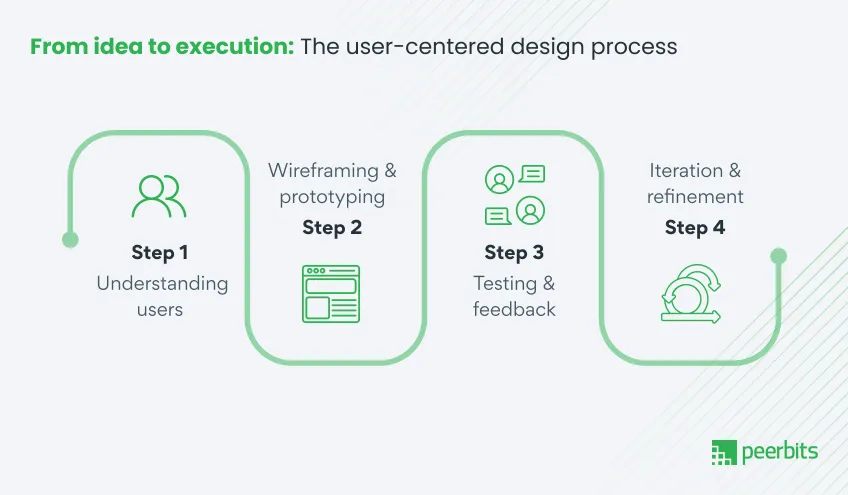
An effective User-Centered Design in Software Development follows a structured cycle of research, prototyping, testing, and refinement. Each stage focuses on building software around user needs, minimizing usability issues, and improving adoption.
Step 1: Understanding users
User research lays the foundation for a functional and intuitive design. Businesses collect data through surveys, interviews, and analytics, creating personas that reflect real user behaviors.
Step 2: Wireframing & prototyping
Wireframes and prototypes map out the user journey before development begins. This early-stage testing saves time and prevents costly design errors.
Step 3: Testing & feedback
A/B testing, heatmaps, and user feedback identify pain points and reveal navigation issues. Testing ensures that users can interact with the product effortlessly.
Step 4: Iteration & refinement
After testing, refinements are made to optimize usability. This cycle continues until the product delivers a smooth experience.
Even after launch, real-time analytics and user feedback help fine-tune interactions and adapt the software to changing user needs.
Key factors for a successful user-centered design
To create User-centered design, Software Development services consider these key elements, that you should also consider:
Accessibility & inclusivity
Designing for all users, including those with disabilities, expands the potential user base and ensures compliance with accessibility standards.
Navigation & usability
A clear and well-organized interface reduces frustration. Logical layouts and intuitive controls help users find what they need effortlessly.
Visual design & interaction
A well-crafted user-centered design architecture enhances engagement, improving brand perception and user retention.
Data-driven decisions
User behavior analytics help businesses refine their interaction design, ensuring the software adapts to evolving needs.
By combining a structured UCD process with key design considerations, businesses can create intuitive, accessible, and high-performing software.
Read more: How code quality affect custom software development? Best practices, and benefits
User-centered design methods and best practices
A well-structured User-Centered Design in Software Development relies on proven methods to improve usability, engagement, and efficiency. These techniques help businesses refine their software based on real user behavior.
User testing
Testing identifies pain points before a product reaches users. A/B testing, usability labs, and heatmaps reveal navigation challenges, helping businesses fine-tune interaction design.
Wireframing & prototyping
Tools like Figma, Adobe XD, and Sketch allow designers to map out user flows before development. This approach prevents costly design flaws and ensures a logical interface structure.
Surveys & interviews
Understanding user expectations is key. Businesses collect qualitative insights through surveys, focus groups, and one-on-one interviews, ensuring the final product aligns with real-world needs.
Persona development
A data-driven persona represents the target audience, helping teams design with real user behaviors in mind. Personas influence everything from UI layouts to feature prioritization.
Accessibility audits
A user-centered design architecture must be accessible to all users, including those with disabilities. WCAG compliance ensures inclusivity by improving readability, contrast, and navigation features.
Using these methods, businesses can reduce usability issues, increase engagement, and improve customer satisfaction.
Core benefits of user-centered design in software development
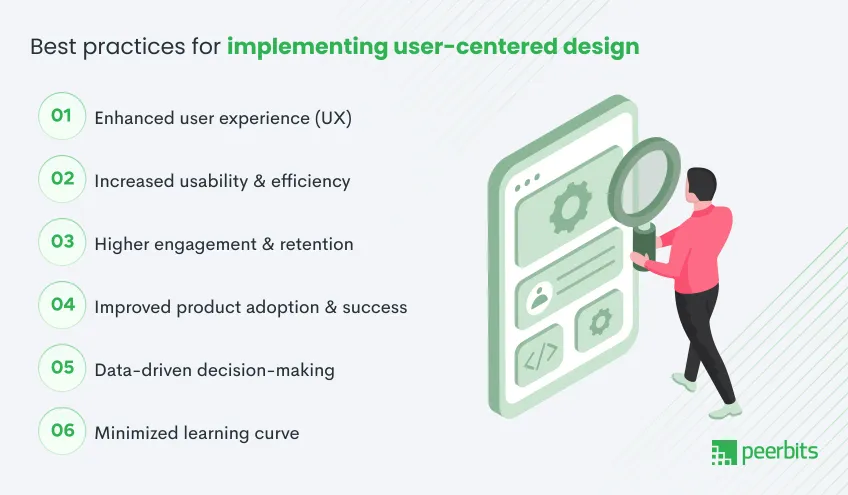
A strong User-Centered Design in Software Development directly influences product success. Businesses that prioritize user needs create software that is not just functional but also intuitive and enjoyable to use.
Enhanced user experience (UX)
A software product designed around user expectations results in a seamless experience. Clear navigation, intuitive interfaces, and logical workflows reduce friction, making interactions effortless.
Increased usability & efficiency
Users should quickly accomplish tasks without unnecessary steps. A well-structured user-centered design architecture ensures features are accessible, helping users complete actions with minimal effort.
Higher engagement & retention
When a product is easy to use and enjoyable, users stick around. A well-designed interface reduces frustration and encourages repeat usage, leading to higher customer loyalty.
Improved product adoption & success
A product that meets user expectations gains faster adoption. Intuitive design encourages new users to explore features without confusion, leading to wider acceptance and stronger market performance.
Data-driven decision-making
User behavior analytics highlight areas for improvement. Heatmaps, session recordings, and A/B testing help businesses optimize their software based on real-world usage patterns.
Minimized learning curve
A complex interface leads to user frustration and drop-offs. A well-structured user-centered design process reduces onboarding time, allowing users to grasp functionality without extensive training.
By focusing on usability, efficiency, and engagement, businesses increase customer satisfaction and long-term product success.
Conclusion
Skipping User-Centered Design in Software Development often leads to low adoption, usability issues, and frustrated users. On the other hand, a well-designed product keeps users engaged, improves retention, and strengthens brand trust. When businesses focus on usability, accessibility, and continuous feedback, they create software that stands out and delivers real value. The importance of user-centered design isn’t just about aesthetics—it directly impacts customer satisfaction and long-term growth.
A strong user-centered design process ensures that products are not just functional but also intuitive and enjoyable. Prioritizing real user needs from the start leads to software that people want to use and recommend.


